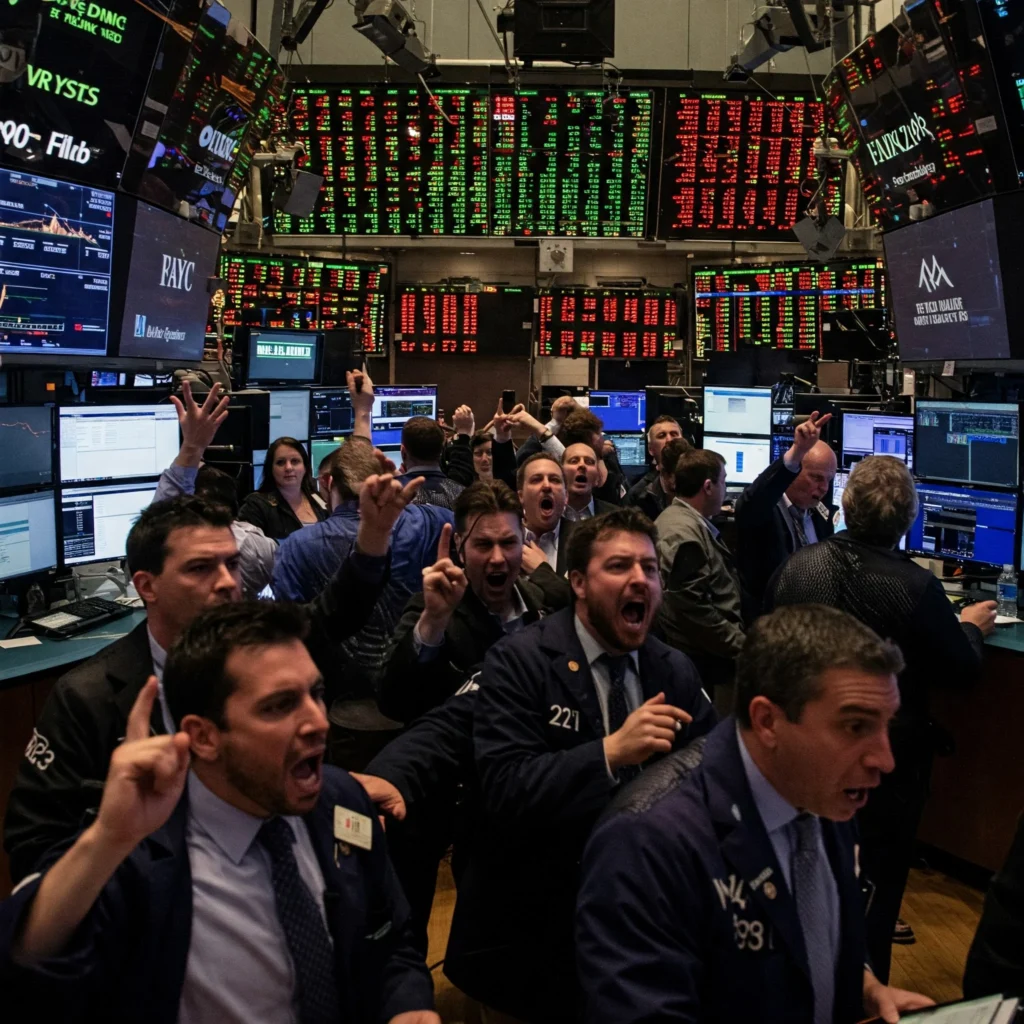New York — It was a turbulent day on Wall Street Monday as U.S. stocks ricocheted wildly, reacting to speculation and statements surrounding President Donald Trump’s escalating tariff strategy.
Markets initially plunged amid global concern over the sweeping U.S. tariffs and their potential to derail economic growth. By the opening bell, U.S. indexes had entered bear market territory. But just an hour later, stocks staged a sharp rally following rumors that the White House might temporarily halt its tariff plans — a development that traders hoped would calm global tensions.
However, the rally was short-lived.
A White House official quickly quashed the speculation, dismissing any talk of a tariff pause as “fake news.” Optimism further unraveled when Trump told reporters he could impose an additional 50% tariff on Chinese imports, effectively dousing hopes of a breakthrough or negotiated resolution.
The result was a dizzying session. After soaring nearly 900 points at one stage, the Dow Jones Industrial Average reversed course, ultimately closing down 349 points, or 0.91%. The S&P 500 slipped 0.23%, while the tech-heavy Nasdaq Composite inched 0.1% higher after a choppy performance.
The Cboe Volatility Index (VIX), often referred to as Wall Street’s “fear gauge,” soared to its highest closing level since the onset of the Covid-19 pandemic. It topped 50 points intraday — a threshold rarely seen and typically associated with extreme investor anxiety.
Monday’s chaos reflected Wall Street’s deep frustration and the market’s hunger for clarity. Even a hint of a tariff delay was enough to trigger a dramatic surge.
“That was a good example of what would happen if we actually got some rational thought mixed in with the ignorant tariff policy,” said Art Hogan, chief market strategist at B. Riley Wealth Management. “The stock market vigilantes have spoken loudly that we need rational thought mixed in with this trade policy. And there is none so far.”
Joe Saluzzi, partner at Themis Trading, called the market’s bounce “a monster move off the low.” Between 9:43 a.m. and 10:17 a.m. ET, the S&P 500 swung 8.5% — a dramatic turnaround within a span of just over 30 minutes. But the rally soon fizzled as reality set back in.
One brief moment of hope came when Ursula von der Leyen, a senior European Union official, said the EU was open to negotiations with the U.S. and had proposed eliminating tariffs on American industrial goods. But that gesture, too, was overshadowed when Trump, speaking from the Oval Office, shut down the idea of a tariff pause.

“We’re not looking at that,” the president said. “We have many, many countries that are coming to negotiate deals with us. And they’re going to be fair deals… In certain cases, they’re going to be paying substantial tariffs.”
The market tremors extended beyond equities. The 10-year Treasury yield rose sharply to 4.155%, reflecting a sell-off in government bonds. Investors dumped safer assets in reaction to the swirling uncertainty, pushing yields higher. (Yields move inversely to bond prices.)
In sum, the day served as a stark reminder of how vulnerable markets are to policy shifts — and rumors — in an increasingly tense global trade landscape.
Markets Turbulent as Trump Holds Firm on Tariffs
Wall Street’s recent volatility may be delivering a mixed message to President Donald Trump, as some analysts argue that financial pressure is necessary to force his administration toward compromise on trade. Others worry that a market rebound could reinforce Trump’s resolve to escalate tariff battles.
“We need this market to crash — to keep the pressure on the administration,” said Ed Yardeni, president of Yardeni Research, in a rare and blunt comment to CNN. He noted that the market’s reaction following so-called “Liberation Day” has spiraled into what he called “Annihilation Days.”
Global Leaders React as Trade Tensions Escalate
On Monday morning, global stock markets were rocked again after President Trump announced plans to impose a fresh wave of tariffs—50% on Chinese imports—by midweek, unless Beijing rolls back its retaliatory 34% duties. Trump also indicated that scheduled talks with Chinese officials would be scrapped, though he suggested that trade discussions with other countries were progressing.
European Commission President Ursula von der Leyen responded swiftly, reiterating the EU’s readiness to negotiate. She reaffirmed a standing offer to eliminate tariffs on industrial goods, including automobiles, stressing the EU’s longstanding willingness to go “zero for zero” with countries that maintain a strong auto industry presence.
Yet, von der Leyen added that while Europe prefers a diplomatic settlement, it is also preparing a list of American goods for potential retaliatory tariffs.
Markets Reflect Rising Anxiety
The CNN Fear and Greed Index plunged to its lowest point this year, underscoring investor unease. Stocks initially wavered Monday as Trump boasted that multiple countries were entering trade discussions with the U.S.
“Tough but fair parameters are being set,” Trump wrote on social media. He added that he had spoken with Japanese Prime Minister Shigeru Ishiba, who reportedly urged him to reconsider recent tariffs against Japan.
U.S. Treasury Secretary Scott Bessent and Trade Representative Jamieson Greer have been tasked with leading the new round of trade talks with Tokyo.
Recession Fears Grow, but Trump Spins Positives
Amid growing concern about a global slowdown, Trump has tried to recast recession fears as potential wins. He noted that U.S. oil prices fell below $60 per barrel—interpreted by some as a signal of weakening global demand. Falling Treasury yields also reflect investor migration to safe-haven assets, potentially lowering rates on mortgages and consumer loans.
In a Monday morning post, Trump touted the benefits: “Oil prices are down, interest rates are down (the slow moving Fed should cut rates!), food prices are down, there is NO INFLATION.” He added that tariffs are funneling “Billions of Dollars a week” into the U.S. from “abusing countries.”
Market Mayhem Spreads Across the Globe
U.S. markets weren’t the only ones feeling the heat. European stocks took a pounding, with the STOXX 600 down 4.5%, London’s FTSE 100 dropping 4.38%, and Germany’s DAX shedding 4.13%. Italy’s benchmark index plunged 5.18%.
In Asia, losses were even more staggering. Japan’s Nikkei 225 fell 7.83%, Hong Kong’s Hang Seng dropped a historic 13.22%—its worst day since 1997—while Taiwan’s index tumbled 9.7%. China’s Shanghai Composite sank 7.34% and the Shenzhen Composite nosedived 9.66%.
Investors cited unclear messaging from the White House regarding tariff negotiations as a key reason for the chaos.
Analysts Warn of Long-Term Damage
Goldman Sachs warned in a note to investors that if Trump proceeds with higher “reciprocal” tariffs on countries with large trade imbalances—as scheduled for Wednesday—the result could be a sharp plunge into a global recession. JPMorgan CEO Jamie Dimon echoed this in his annual letter to shareholders, stating that such tariffs would raise prices and slow economic growth.
The Trump administration’s current tariffs include a baseline 10% rate applied universally since Saturday, alongside more specific levies: 25% tariffs on auto parts, steel, and aluminum, and similar duties on imports from Canada and Mexico. Additional tariffs on auto parts are slated for early May, with others on lumber, pharmaceuticals, copper, and microchips potentially on deck.
Trump’s Commitment to Tariffs Undeniable
Commerce Secretary Howard Lutnick confirmed the administration’s intentions in a blunt Sunday interview: “The tariffs are coming. (Trump) announced it, and he wasn’t kidding. Of course they are.”
Whether Trump continues down this path or pulls back amid economic fallout will be the defining factor in determining if the U.S.—and by extension, the world—can avoid a deep recession. Investors, allies, and rivals are watching closely. The stakes could not be higher.


